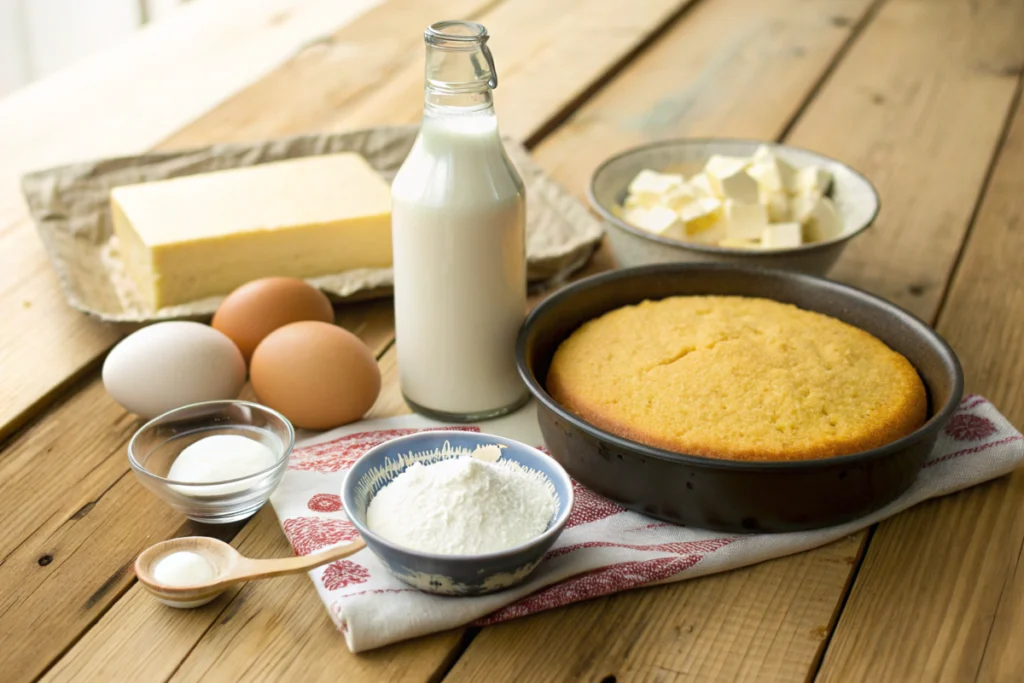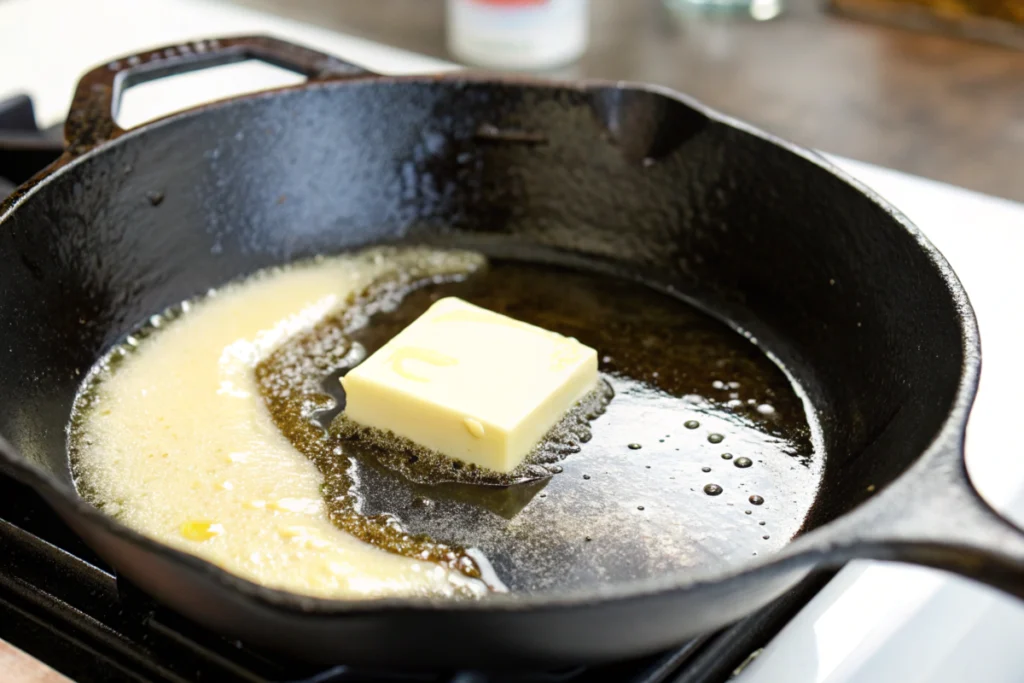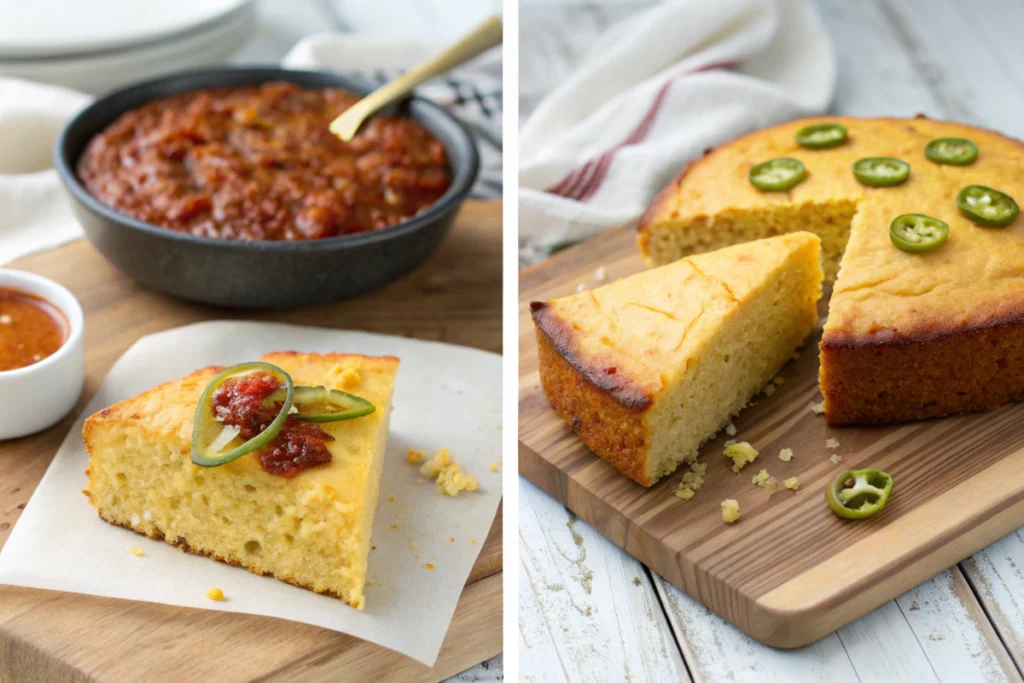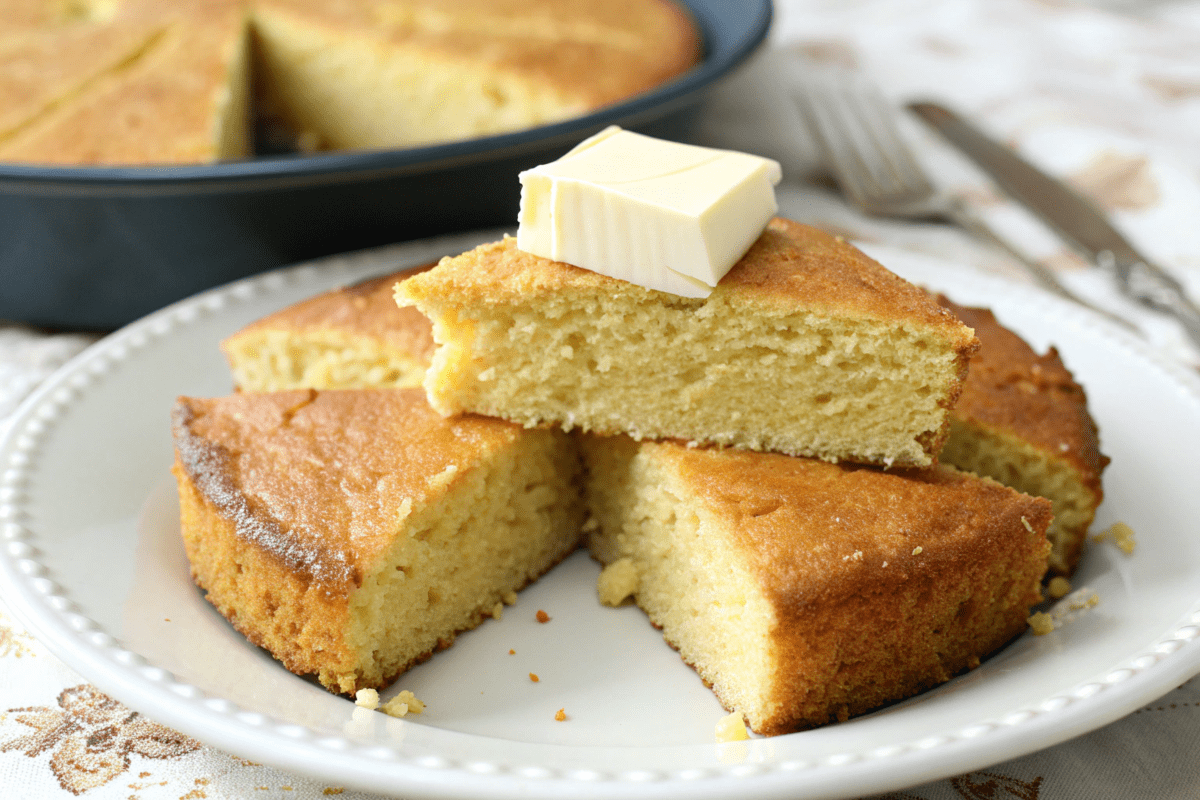Introduction: Southern Cornbread Recipe
Southern cornbread is a timeless classic that represents the heart of Southern cooking. Known for its golden crust and fluffy interior, this recipe holds a special place in Southern kitchens. Unlike sweetened cornbreads, traditional Southern cornbread focuses on the natural flavor of cornmeal, which pairs perfectly with hearty stews, barbecues, or a pat of melted butter. In addition, it’s incredibly easy to prepare, making it an excellent choice for both beginners and experienced cooks alike.
This guide will walk you through the steps to create the perfect Southern cornbread using simple, authentic ingredients. Thus, you’ll be able to enjoy a dish that’s rich in tradition and flavor. Whether you’re making it for a family gathering or a quiet dinner, this recipe is sure to impress. On the other hand, if you prefer variations like adding cheese or jalapeños, this recipe serves as the perfect base for customization.
History and Origins of Southern Cornbread Recipe
Southern cornbread has deep roots in American history, dating back to Indigenous communities who first used corn as a staple ingredient. European settlers adopted this technique, creating a dish that evolved into the cornbread we know today. In addition, cornbread became a favorite in Southern cuisine due to its affordability and versatility.
Unlike Northern cornbread, which often includes sugar, Southern cornbread remains savory and is traditionally baked in a cast-iron skillet. Therefore, it develops a signature crispy crust that enhances its flavor and texture.
Ingredients for Southern Cornbread Recipe

The beauty of a traditional Southern cornbread lies in its simplicity. With just a few pantry staples, you can create a dish that’s both comforting and satisfying. In addition, these ingredients are easy to find, making it a convenient recipe to whip up anytime.
Essential Ingredients
Butter or Bacon Drippings (2 tablespoons)
Melted butter or bacon drippings add richness and flavor. In addition, they help create the signature crispy crust when poured into a hot skillet.
Cornmeal (2 cups)
Use fine or medium ground yellow cornmeal for the best texture. On the other hand, white cornmeal can be used for a milder flavor, depending on your preference.
Buttermilk (1 ¾ cups)
Buttermilk adds tanginess and helps create a moist crumb. If you don’t have buttermilk on hand, mix 1 tablespoon of lemon juice or vinegar with regular milk as a substitute. Thus, you can still achieve the same result without a trip to the store.
Eggs (2 large)
Eggs provide structure and help bind the ingredients together. Beat them lightly before mixing to ensure even distribution in the batter.
Baking Powder (1 tablespoon)
Baking powder helps the cornbread rise, giving it a light and fluffy texture. However, be sure to measure it accurately to avoid an overly dense or bitter loaf.
Salt (1 teaspoon)
A small amount of salt enhances the natural flavors of the cornmeal.
Preparation: How to Make Southern Cornbread Recipe

Making Southern cornbread Recipe is a straightforward process that requires only a few steps. In addition, it takes less than 30 minutes from start to finish, making it perfect for a quick side dish or snack. Follow these steps to create golden, crispy cornbread with a soft and tender crumb.
Step 1: Preheat the Oven
Start by preheating your oven to 425°F (220°C). Place a cast-iron skillet in the oven while it heats. Thus, the skillet will be hot enough to create the cornbread’s signature crispy crust.
Step 2: Prepare the Dry Ingredients
In a large mixing bowl, combine the cornmeal, baking powder, and salt. Stir them together to ensure even distribution. However, avoid over mixing, as it can impact the final texture.
Step 3: Mix the Wet Ingredients
In a separate bowl, whisk together the butter milk and eggs until smooth. Slowly pour this mixture into the bowl with the dry ingredients . Stir gently until just combined. On the other hand, if the batter feels too thick, you can add a splash of milk to loosen it.
Step 4: Add the Melted Fat
Melt butter or bacon drippings in the preheated skillet. Carefully pour most of it into the batter, leaving about a tablespoon in the skillet. Mix the melted fat into the batter gently. In addition, this step ensures the batter absorbs the rich flavor and creates a golden crust.
Step 5: Bake the Cornbread
Pour the batter into the hot skillet and spread it evenly. Place the skillet in the oven and bake for 20–25 minutes, or until the top turns golden brown and a toothpick inserted in the center comes out clean. Therefore, keeping an eye on the baking time will help you avoid overcooking.

Step 6: Serve and Enjoy
Remove the skillet from the oven and let the cornbread cool for a few minutes. Slice it into wedges and serve warm with butter, honey, or your favorite accompaniments. Thus, this classic dish is ready to impress your guests or satisfy your cravings.
Variations and Customizations for Southern Cornbread Recipe

Southern cornbread Recipe is delicious on its own, but you can easily customize it to suit your taste or dietary preferences. In addition, these variations can elevate the classic recipe, giving it a unique twist for special occasions or everyday meals.
Add-Ins for Extra Flavor
- Cheese and Jalapeños
Mix shredded cheddar cheese and chopped jalapeños into the batter for a spicy, cheesy kick. Therefore, this variation pairs perfectly with chili or barbecued meats. - Corn Kernels
Fold in a handful of fresh or frozen corn kernels for added sweetness and texture. On the other hand, you can use canned corn if fresh isn’t available. - Herbs and Spices
Add chopped fresh herbs like rosemary or thyme, or a sprinkle of paprika or cayenne pepper, to give your cornbread an herby or smoky flavor. However, be cautious with stronger spices to avoid overpowering the cornbread’s natural taste.
Healthier Options
- Gluten-Free Cornbread
Substitute regular flour with gluten-free flour or omit it entirely if using finely ground cornmeal. Thus, you can enjoy this Southern classic without compromising dietary restrictions. - Lower Fat Version
Replace the butter or bacon drippings with olive oil or a non-dairy alternative for a lighter version. In addition, this option is ideal for those watching their fat intake. - Vegan Cornbread
Use plant-based milk (like almond or soy milk) and a flaxseed egg substitute instead of buttermilk and eggs. Therefore, you can create a vegan-friendly version without sacrificing texture or flavor.
Serving Suggestions for Southern Cornbread Recipe
Southern cornbread Recipe is incredibly versatile and complements a variety of dishes. Whether you serve it as a side or enjoy it on its own, there are countless ways to enhance its flavor. In addition, creative serving ideas can make this humble dish the star of any meal.
Classic Pairings
- With Chili or Stews
Pair cornbread with a warm bowl of chili, beef stew, or gumbo. The slightly crumbly texture of cornbread absorbs the flavors of these hearty dishes perfectly. Therefore, it acts as both a side and a natural sponge for savory sauces. - Alongside Fried Chicken
Serve cornbread with crispy fried chicken for a quintessential Southern meal. However, adding honey or butter to the cornbread can provide a sweet contrast to the chicken’s savory crunch. - With Greens and Beans
Complement cornbread with collard greens or black eyed peas for a traditional Southern spread. In addition, these dishes provide a nutritious balance to the richness of the cornbread.
Creative Serving Ideas
- Cornbread Croutons
Cube leftover cornbread and toast it to make flavorful croutons for salads or soups. On the other hand, you can season the cubes with garlic or herbs for extra flavor. - Cornbread Breakfast Bowl
Top crumbled cornbread with scrambled eggs, avocado, and salsa for a hearty breakfast bowl. Thus, this transforms the classic recipe into a satisfying morning meal. - Cornbread Dessert
Drizzle warm cornbread with honey, maple syrup, or whipped cream for a simple dessert. However, be sure to use a slightly sweetened cornbread for this variation.
Nutritional Breakdown of Southern Cornbread Recipe
Southern cornbread is not only a comforting dish but also provides several essential nutrients. While its nutritional profile depends on the ingredients and variations you use, this break down highlights the benefits of a traditional recipe. In addition, it explains how cornbread fits into a balanced diet.
Calories and Macronutrients
- Calories
A standard serving of Southern cornbread (1/8 of an 8-inch skillet) contains about 180–200 calories. However, adding ingredients like cheese or bacon drippings can increase the calorie count. - Protein
Cornbread provides about 4–5 grams of protein per serving, mainly from eggs and butter milk. In addition, pairing it with high protein dishes like chili enhances its nutritional value. - Carbohydrates
With around 20–25 grams of carbohydrates per serving, cornbread is a good energy source. On the other hand, it may not suit low carb diets unless modified. - Fat
Traditional recipes contain 8–10 grams of fat per serving, derived from butter or bacon drippings. Therefore, using low-fat or non dairy alternatives can make it lighter.
Vitamins and Minerals
B Vitamins
Cornmeal is a source of B vitamins like thiamine and niacin, which are essential for energy production and maintaining healthy skin. However, these benefits may vary with the type of cornmeal used.
Calcium and Phosphorus
Thanks to butter milk, Southern corn bread provides calcium and phosphorus, which support bone health. In addition, these nutrients aid muscle function.
Iron
Cornmeal contains small amounts of iron, contributing to healthy red blood cell production. Thus, it can help prevent mild iron deficiencies when paired with iron-rich foods.
FAQs About Southern Cornbread
Can this Southern cornbread Recipe be made gluten free?
Traditional Southern cornbread does not include sugar, focusing instead on its savory flavors. However, some modern variations incorporate small amounts of sugar for a slightly sweet twist.
Heating a cast-iron skillet in the oven before adding the batter ensures a crispy crust. In addition, using bacon drippings or butter in the skillet enhances the flavor and texture.
Yes, you can substitute buttermilk with a mixture of regular milk and lemon juice or vinegar. Thus, this replacement mimics the tangy flavor of buttermilk.
Northern cornbread is often sweeter and softer, while Southern cornbread is savory, dense, and has a crispy crust. On the other hand, both versions use similar core ingredients like cornmeal and flour.
Popular additions include jalapeños, cheese, corn kernels, or herbs. In addition, these ingredients can elevate the flavor while maintaining the cornbread’s traditional appeal.
Yes, you can substitute regular flour with gluten-free alternatives or use pure cornmeal for a flour-free version. Therefore, this adaptation is suitable for gluten-sensitive individuals.
Store leftover cornbread in an airtight container at room temperature for up to 2 days. However, for longer storage, refrigerate it for up to a week or freeze it for up to 3 months.
Self-rising cornmeal works well and simplifies the recipe since it already contains baking powder and salt. On the other hand, ensure the additional leavening matches the recipe’s requirements.

